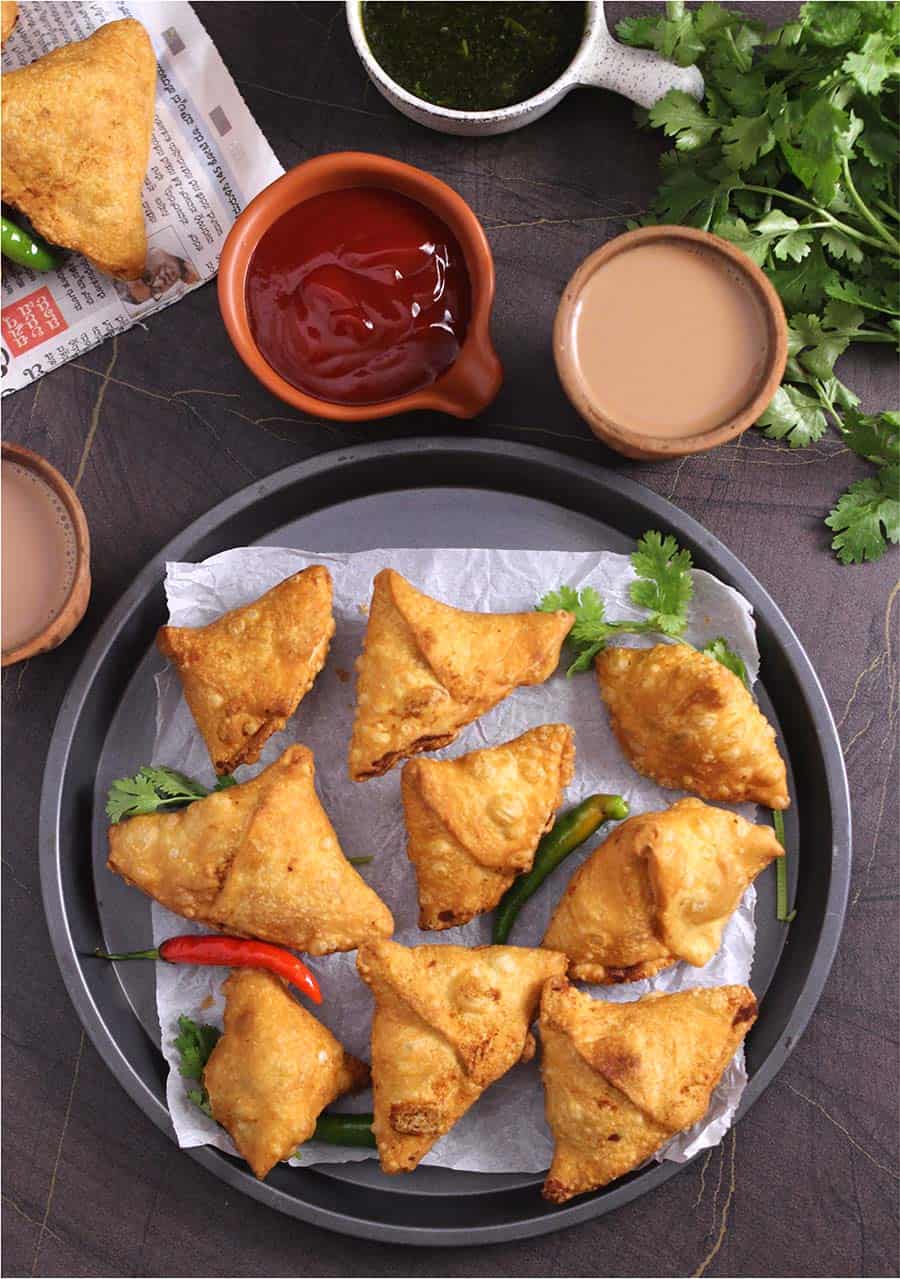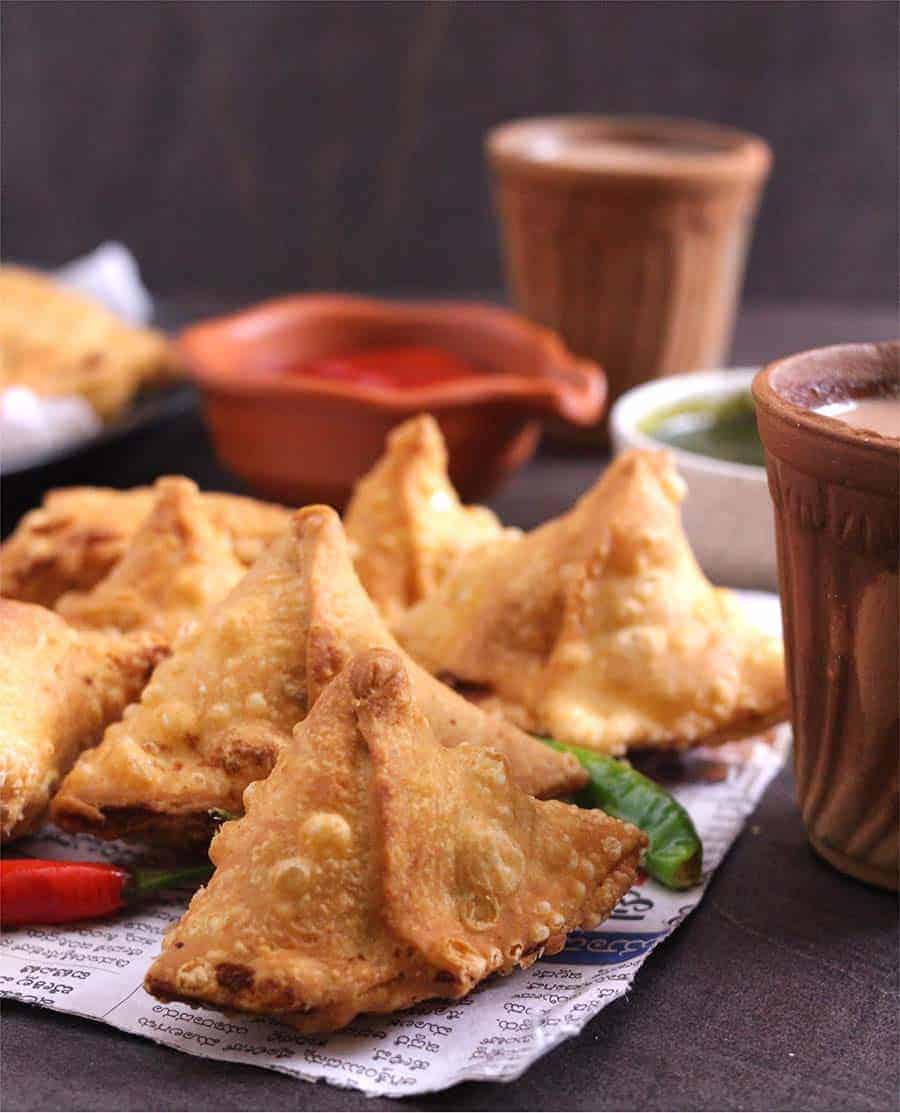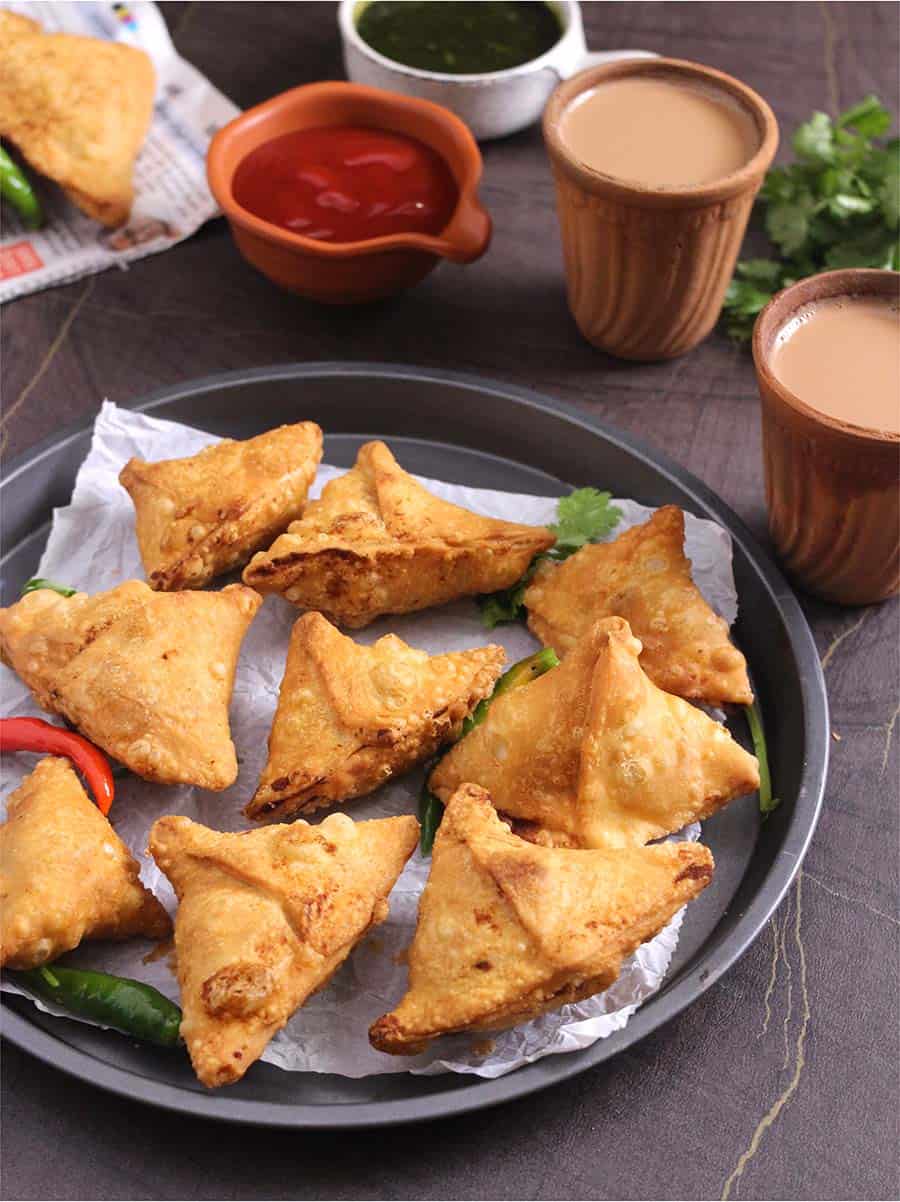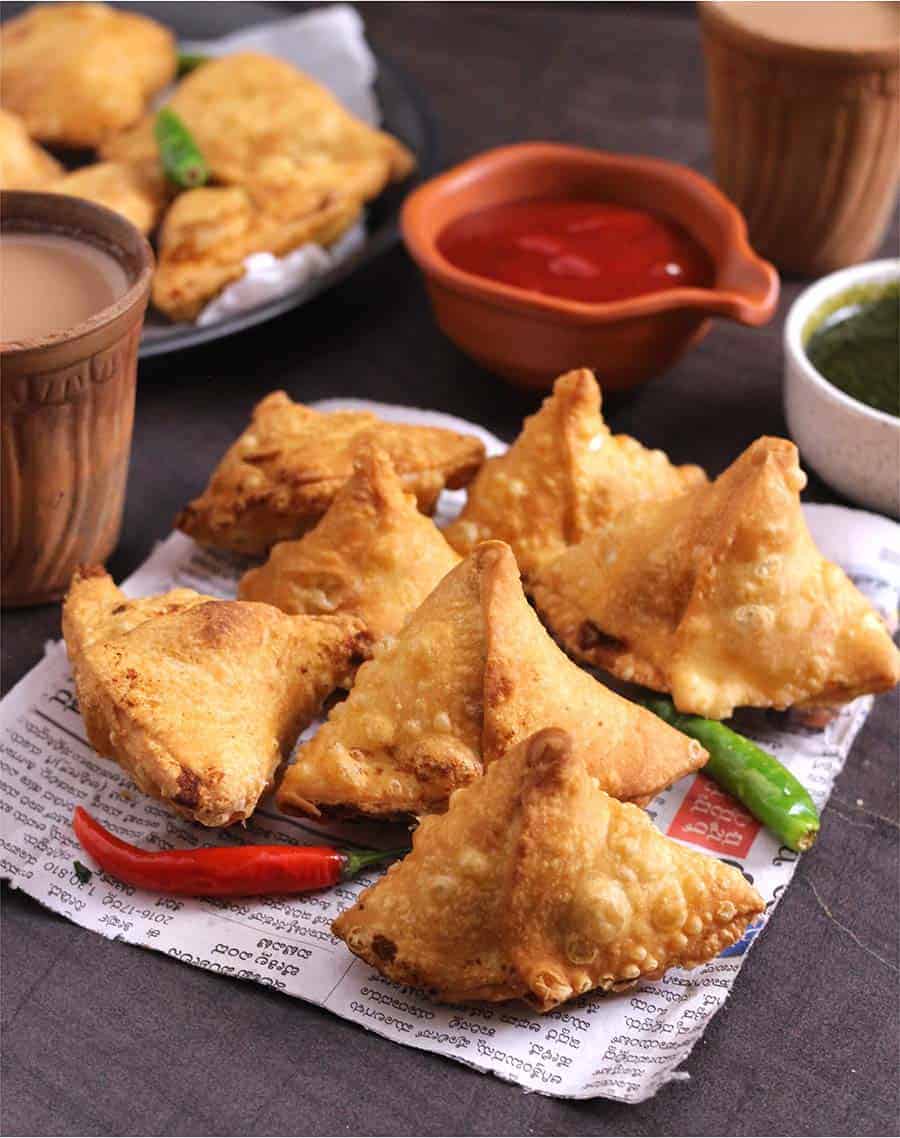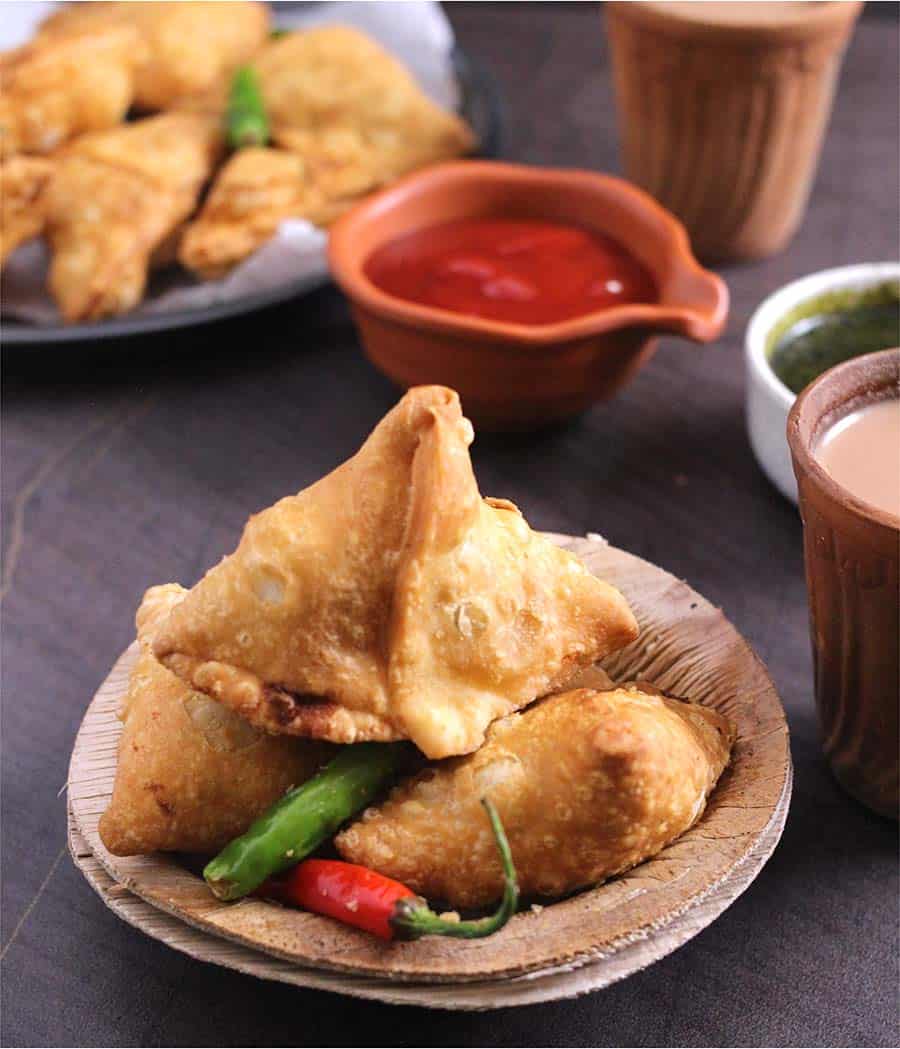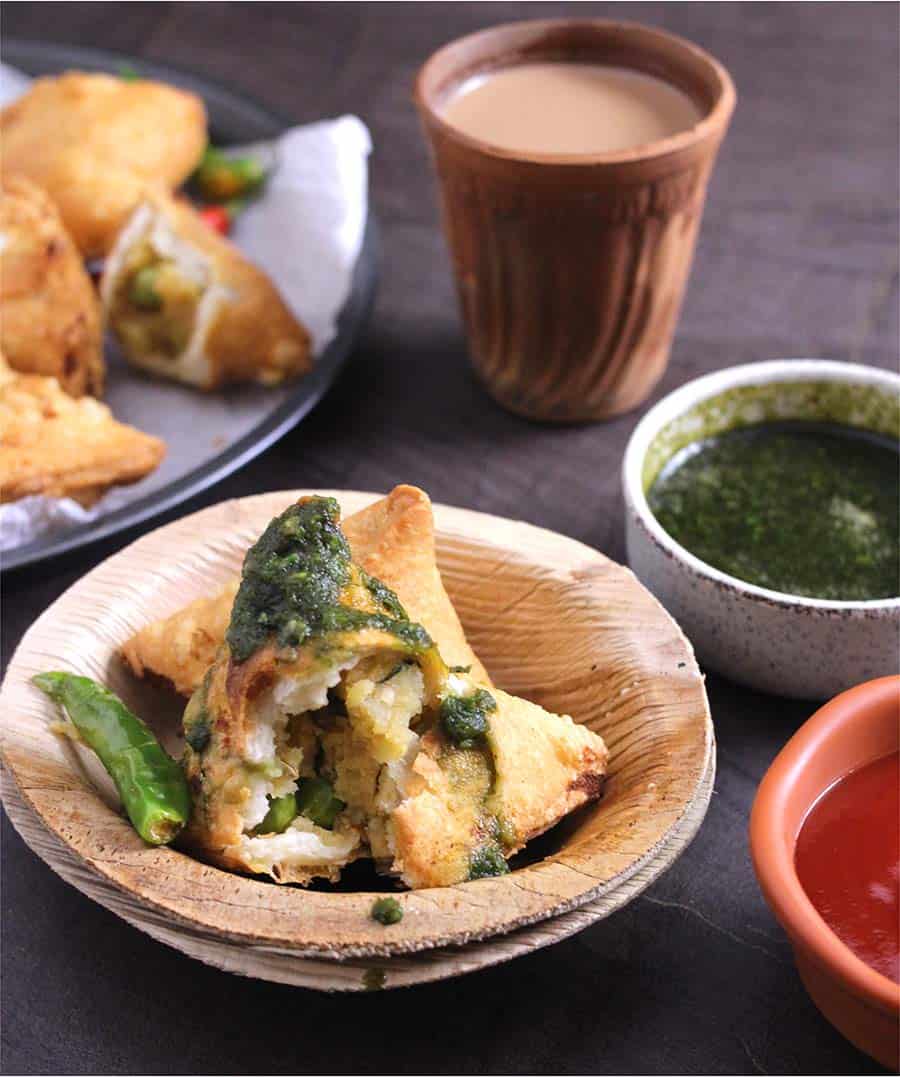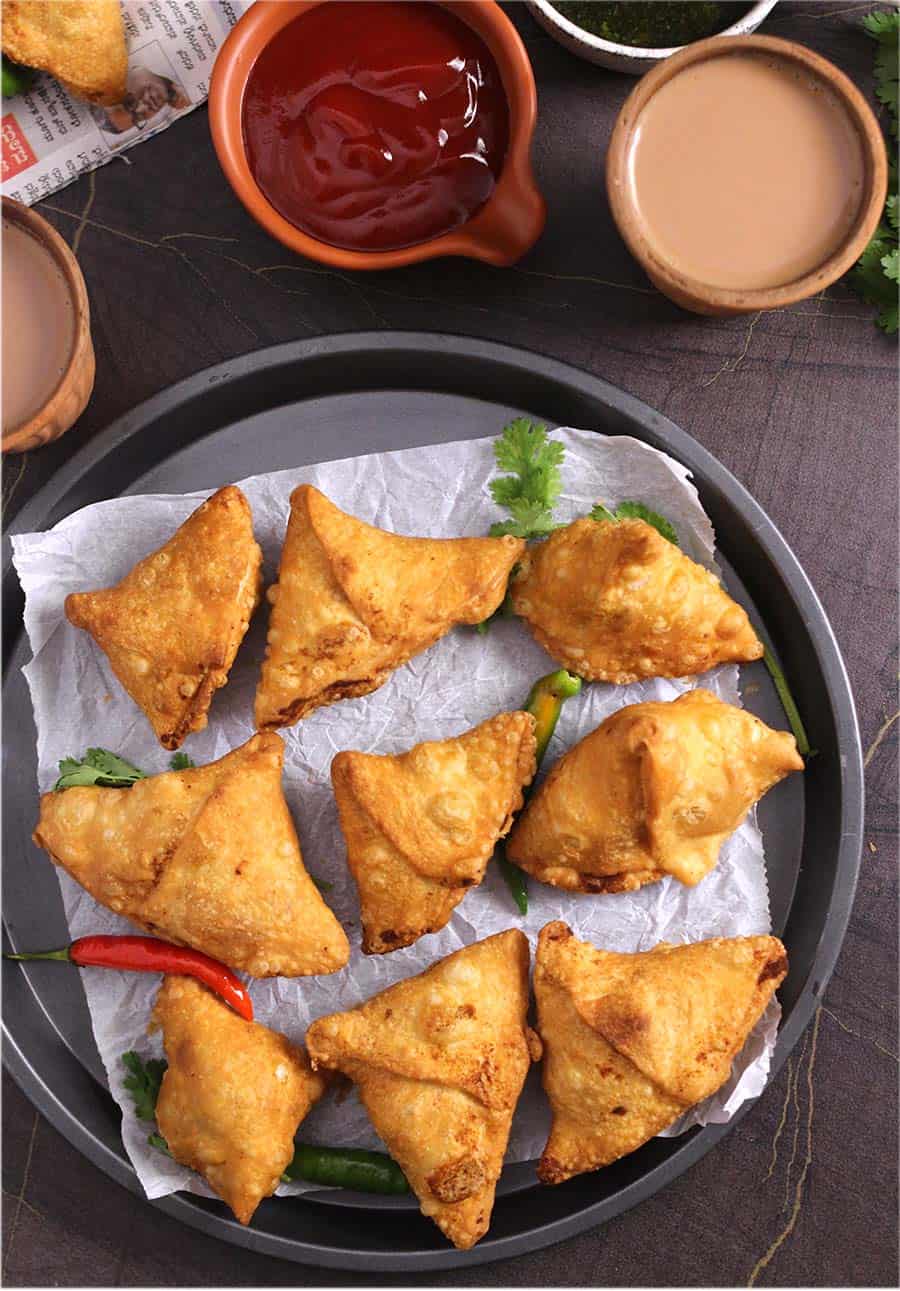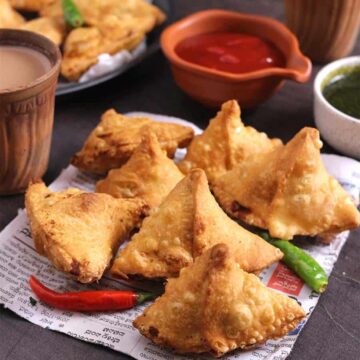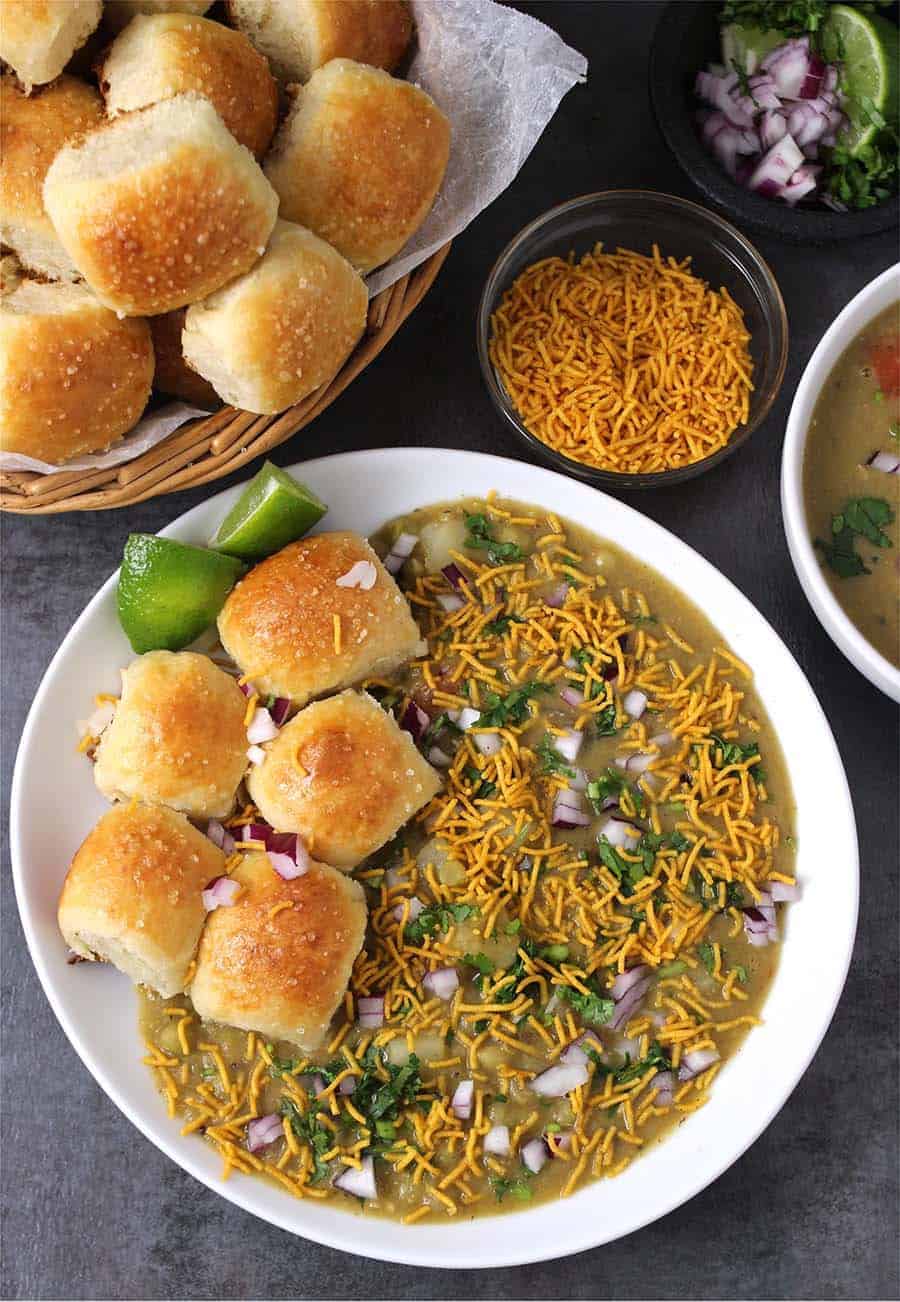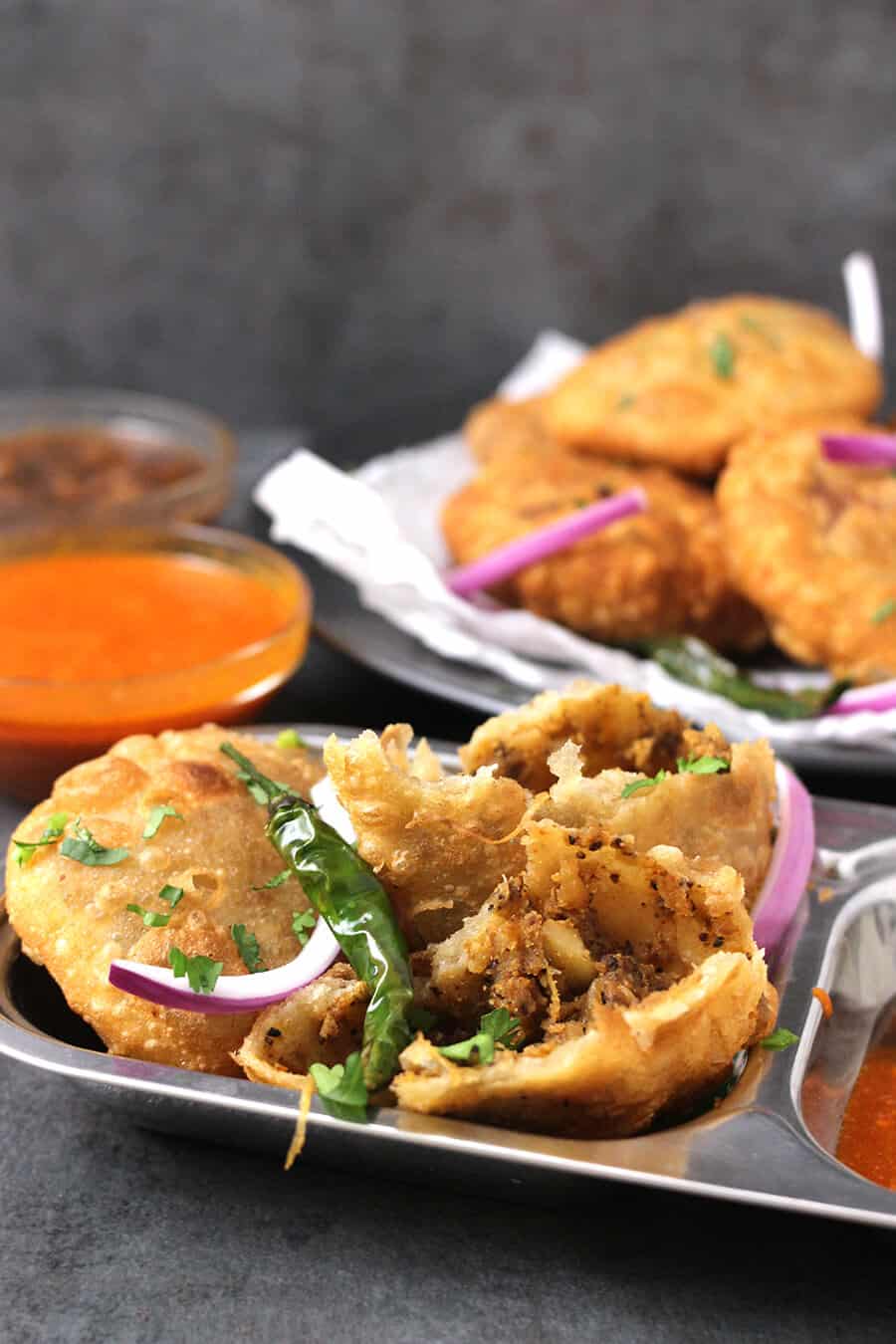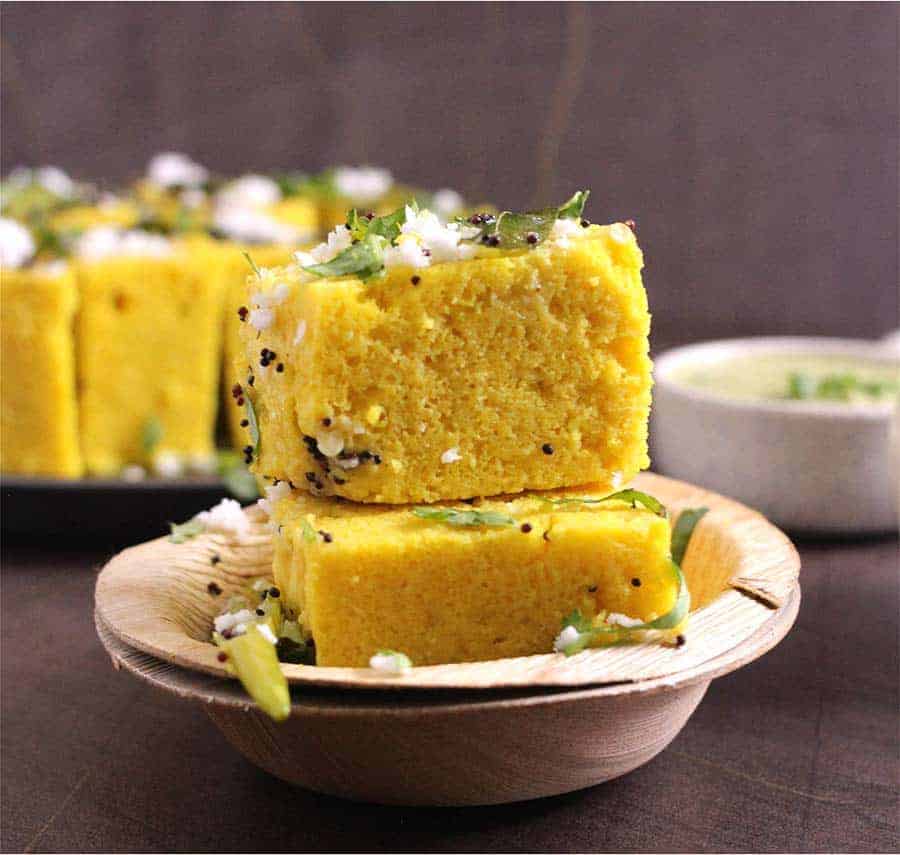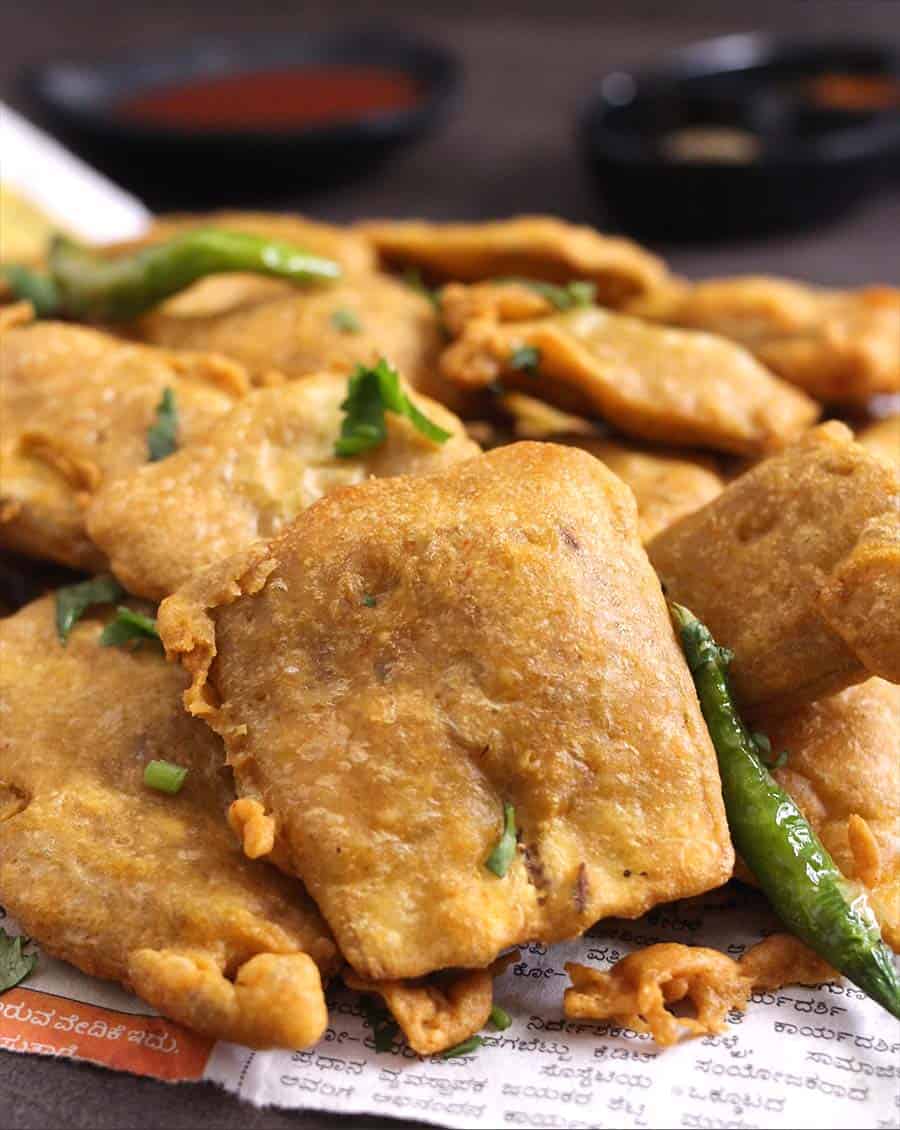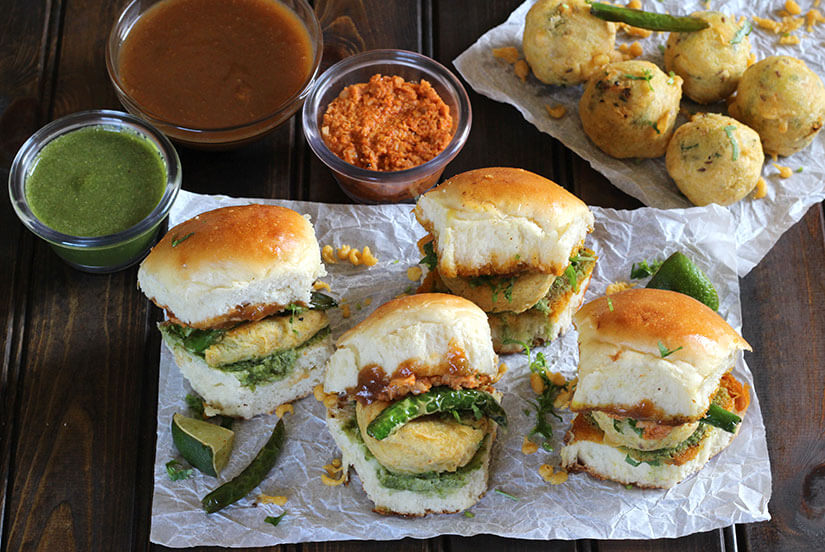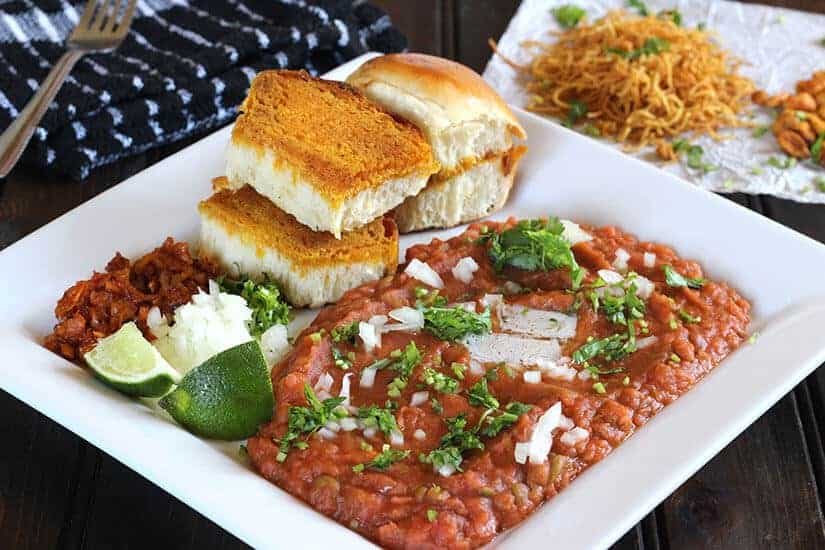This samosa recipe is vegetarian/vegan and can be served as an appetizer, snack, or finger food with mint chutney, dates chutney, or tomato ketchup/sauce.
Samosa or Singara or Sambusa is popular South Asian, Indian street food where the pastry is filled with savory fillings like vegetables or meat and are then deep-fried or baked or air-fried. It can be triangular, conical, half-moon or cresent shaped. Filling or stuffing inside samosa can vary from potato (aloo), onion, lentils, paneer, noodles for vegetarian variations. For non-vegetarian versions, the fillings include egg, keema, lamb, chicken, or any meat of your choice. The filling choice varies depending on the region you are from and your local food habits. My all-time favorite is the one with potato and green peas filling (a Punjabi samosa), and nothing can replace this 🙂
Any birthday party, office party, get together, or quick office meeting you attend samosa and cup of chai is quite common. Am I right, folks? They are popular during Ramadan eaten as Iftar snacks, and during festivals like Diwali, Holi, Rakhi, or Christmas . And during the rainy season, all I want is a cup of steaming hot chai (tea) or coffee and some spicy samosa.
After the first few failures in making the samosa, I learned these few tips.
To get that flaky and crispy outer cover, you have to rub the flour into the oil. This process is similar to making pie crust dough. This step is a must. For crispy samosa, the dough should be stiff. If you add too much water or the dough is too soft upon kneading, you will not get that crispy crust. Always fry the samosa on medium flame, and for street style or traditional authentic results fry on low flame. You can check that method here on ALOO KACHORI. Never be in a hurry and fry on high flame. Frying on a high flame may turn the outer surface of the samosa cover to brown soon, while the dough remains uncooked.
For the samosa dough 2 cups All-purpose flour or Maida ½ teaspoon Salt ¼ cup Cooking oil of your choice (I use coconut oil) ¼ cup + 3 tablespoon of Water For the potato peas filling or aloo matar filling (Adjust all the spices to taste) 4 medium Potatoes 2 tablespoon Oil 1 tablespoon crushed Coriander seeds 1 teaspoon Cumin seeds 1 teaspoon Saunf or Fennel seeds Hing or Asafoetida (powder or whole), pinch 1 tablespoon Ginger, finely chopped 2 Green chilies, chopped ¾ cup Green peas (fresh or frozen) ½ teaspoon Garam masala or Tandoori masala or Curry powder ½ teaspoon Chaat masala or Amchur powder ½ teaspoon Red chile powder ½ to ¾ teaspoon Salt, adjust to taste 1 tablespoon Coriander leaves or Cilantro, chopped Oil for frying
In a bowl, add flour, salt, and mix. To this, add oil in parts and mix using your fingers. Rub the flour in oil till oil is incorporated with flour. When you take a portion of the mixture and press it between your palm, it should not crumble but hold the shape. Now add the water in parts and mix till everything comes together and a stiff dough is formed. This will be similar to pie dough. Do not add all water at once. First, add ¼ cup and then in 1 tablespoon increments. Cover the dough and let it rest for 30 to 45 minutes.
Boil potatoes in any way you prefer (stovetop, pressure cooker, instant pot, or microwave). I generally place a trivet in a pressure cooker filled with enough water and then place the bowl with potatoes and pressure cook for 3 to 4 whistles. After natural pressure release peel the skin of potatoes, roughly chop if needed and keep them aside. In a pan, add oil, coriander seeds, cumin seeds, fennel seeds, and hing and saute till this sizzles on medium flame. To this, add ginger and green chilies and saute for another 30 seconds to 1 minute Now add potatoes, green peas, garam masala, chaat masala, red chile powder, salt, coriander leaves, and using a potato masher, nicely mash till everything is well combined. Switch off the flame and let the mixture cool.
Once the dough is rested, divide them into 8 balls. Take one dough ball at a time, keep others covered. In a small bowl, mix water with little flour to form a slurry. This slurry is used as glue while forming samosa. Roll them into an oval shape and cut them in the center to create two parts (for better understanding, check my video on making samosa). When you cut, it may pull back, so you gently roll each part again if needed. Apply the slurry to half the side of the cut part and half the side of the oval. Now bring the ends of the cut part together and pinch to form a cone. Check the video on how to fold samosa. Fill the samosa with filling. Finally, pinch the edges together. Trim off any excess dough from the ends if needed. Your 1st samosa is ready. Repeat the process for remaining dough. Keep the filled samosas covered till you are ready for frying
In a pan on medium flame, heat oil for frying. To check if the oil is hot, drop a small scrap piece of dough into the oil, and it should sizzle slowly and come up. Once the oil is hot, drop 3 to 4 filled samosas depending on the size of the pan. Do not flip or disturb them immediately upon dropping them in the oil. Flip after a minute or two once they become firm and fry them on medium flame till the outer cover gets browned and crispy on all the sides, flipping it during the cooking process. Repeat the process for the remaining filled samosas. Enjoy the fried samosas with sweet chutney, mint chutney, tomato ketchup, and a hot cup of tea or chai or coffee.
Always fry the samosas on medium flame. Do not fry on high flame. Frying on a high flame may turn the outer surface of the samosa cover to brown soon, while the dough remains uncooked. Adjust all the spices to taste. The number of samosas you make will vary depending on their size. The addition of crushed coriander and fennel seeds is a must in Punjabi samosas. However, if you are not a big fan of whole spices, you can skip this altogether.
Place a trivet with 1 cup of water in the bottom of your pot. High pressure for 10 to 12 minutes with natural release. Don’t substitute completely. Make 1 :1 ratio! For 1 cup flour use 1 cup wheat flour or atta. The outer texture may vary slightly.
Yes. To make it richer, you can use desi ghee or butter. But to make it vegan, oil is best. I generally use coconut oil. Use any oil of your choice. You can even use vegetable shortening or dalda. The addition of fat (oil/ghee) will give you a flaky crust or outer covering for the samosa. Just make sure you rub oil into the flour until well incorporated. Yes. to speed up the process you can use spring roll wrappers (check my recipe for SCHEZWAN SAMOSA) or puff pastry sheets as outer covering for samosas (see my recipe for PUFF SAMOSA). You can place them in an airtight container at room temperature for a day or in refrigerator for up to 5 days. You can reheat in an oven preheated at 350 degrees F till it gets warm, or reheat in a microwave for 1 minute. Yes. you can fill the samosas and place them in a plate or a baking tray lined with parchment paper and freeze till it becomes firm. Once firm, remove and place them in a Ziploc bag and use as needed. You can deep fry, air fry or bake samosas once thawed to room temperature.
Once the samosas are filled and shaped, you can brush them with oil and air fry at 350 degree F for 20 minutes. Line the filled and shaped samosas on a baking sheet lined with parchment paper in a single layer with sufficient space for heated air to circulate. Bake in preheated oven at 350 degrees F for 30 minutes or until it is cripsy and golden brown. If you have leftover samosas, you can make the popular samosa chaat using chole, sweet chutney, mint chutney, sev, and chopped onions. You can also sandwich them between slices of chutney lathered bread or pav or bun or rolls. If you have leftover samosa filling, the best recipe to make is aloo peas tikki or potato peas kebab. This would be a great snack with tea or coffee. Some other recipes with leftover fillings would be samosa rolls, roll ups, batata vada, or simply mix it with some curds and serve it with steamed rice.
Your samosas may not have turned crispy only for two reasons - either your dough was soft or you fried it on high flame and removed it from oil early. Therefore, make sure the dough is stiff (low water content, and proper oil:flour ratio), and fry samosas on low/medium flame for a longer time to get crispy samosas every single time. If your dough did not have the right amount of water (resulting in a very stiff dough), then samosas will turn hard. If you add too much water while making the dough or form a soft dough then the samosas absorb oil while frying and turns oily. Also if you drop samosas in oil when it is not hot enough, it will absorb oil.
Recipe card
If you like this Samosa recipe - a popular Indian street food
Don’t miss to check out some of my delicious Indian street food recipes to try this festival and holiday season, parties, or any time of the year. For more recent updates, follow me on Pinterest, Instagram, Twitter Click below to save it on Pinterest
